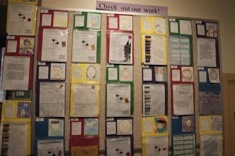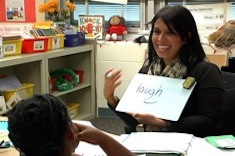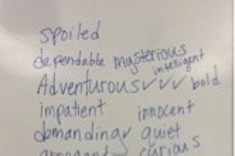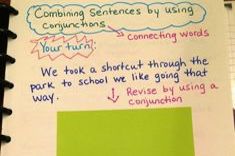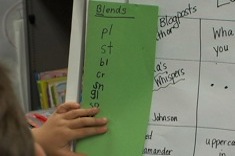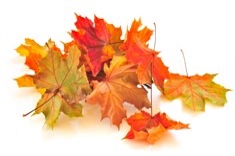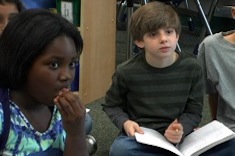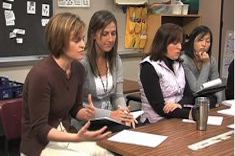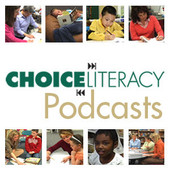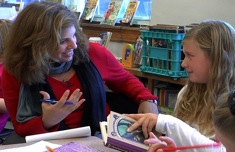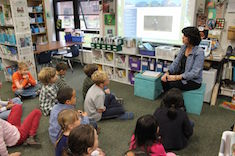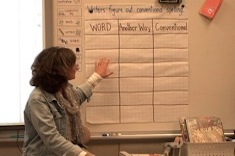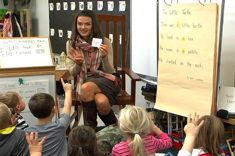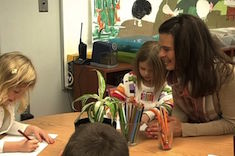Word Study and Vocabulary
Here is where you will find resources for teaching students about spelling, word features, vocabulary, and grammar.
Latest Content
Going Public with Word Work
Maria Caplin is discouraged at the low level of transfer of new vocabulary in her fifth graders’ writing, so she makes some changes in her classroom.
English Language Learners First-Grade Guided Group
Stella Villalba leads a guided reading group of first-grade English language learners, beginning with building vocabulary.
Character Traits and Vocabulary Development
Gigi McAllister shares how she combines vocabulary instruction with analysis of character traits in her fourth-grade classroom.
My Middle Schoolers Still Can’t Spell!: Focusing on Individual Students
Gretchen Taylor concludes her two-part series on spelling instruction in middle school. In this installment, Gretchen visits a colleague in the primary grades to get advice and practical insight.
Rethinking Grammar Instruction in High School
What conventions can be taught in a way that sticks with older adolescents? Gretchen Schroeder slows down and focuses to improve her instruction.
Word Work Basics
Max Brand explains the basics of word work, including a list of reflective questions teachers can ask themselves and students.
Student-Generated Blends Chart in First Grade
Katie DiCesare’s first graders add to a blends chart during reading transition time.
Introducing Onomatopoeia Minilesson
Christi Overman teaches her second graders about onomatopoeia in a brief minilesson.
My Middle Schoolers Can’t Spell!
Gretchen Taylor has a common teacher's lament about spelling, so she decides to do something about it. This is the first installment in a two-part series.
Launching a Sort
Launching a sort with primary students early in the year begins not with words, but with leaves for Max Brand.
Endings Minilesson with Second Graders
Cathy Laker uses her own writing as a mentor text with her second-grade students to demonstrate options for endings.
Capturing the Elementary Years with Photo Essays
Justin Stygles helps his sixth graders prepare to move to middle school with a photo essay assignment in the last weeks of school.
Mentor Reader: Words
Gigi McAllister writes about a quick activity for modeling word learning and fostering discussion of new vocabulary.
Conferring About Word Learning
Sean Moore teaches second grader Mikhail some strategies for learning words in a conference.
Owl Research Word Study
Andrea Smith leads a whole-class discussion of recording new content vocabulary in reading notebooks.
Word Observations
Max Brand describes how word observations can work as powerful minilessons in elementary classrooms.
Simplifying Word Study
Max Brand has suggestions for simplifying word study.
Katie DiCesare on Word Learning (PODCAST)
Katie DiCesare chats with Franki Sibberson about word learning in Katie’s first-grade classroom.
Conferring About Lemony Snicket and Vocabulary
Aimee Buckner confers with fourth grader Samantha about reading a series and tackling challenging vocabulary at the same time in this brief video.
So You Think You Can Combine Sentences? You Can!
Heather Rader concludes her series on sentence combining with a four-step process to help teachers explore the sentence combining craft on their own.
Sentence Combining in Workshops
Heather Rader has strategies for using sentence combining in literacy workshops.
A Tool Worth Exploring: Sentence Combining
Heather Rader begins a new series on sentence combining, an alternative to traditional drill and kill grammar instruction.
Explanatory Grammar Moves: Getting Verbal with It
Jeff Anderson concludes his series on explanatory grammar moves by exploring participles, included in the Common Core eighth-grade standard covering the use of verbals.
Formative Spelling Assessment
Max Brand has developed templates for grades K-2 and 3-5 to use for formative spelling assessments.
Words Chart Minilesson
Ruth Ayres develops a word chart in this brief minilesson with second graders.
Explanatory Grammar Moves: Right-Branching Sentences
Jeff Anderson continues his Explanatory Grammar Series with a feature on the power of right-branching sentences.
Spelling Cycles: An Alternative to Weekly Spelling Lists
Max Brand developed Spelling Cycles as an alternative to weekly spelling tests. He explains how they work with an example from a third-grade class.
Word Nerds
What words are worthy of study? Amanda Adrian and Heather Rader explore that question with colleagues.
Adding to a Word Wall in Kindergarten
Mandy Robek introduces a new word to her kindergartners for their word wall.
Teaching Syllable Breaks in Kindergarten
In kindergarten, table groups are a natural and informal way to help groups of students learn new skills through eavesdropping. In this short video from Mandy Robek's kindergarten class, Mandy targets the same skill of defining syllables during individual conferences at the table so that the learning is reinforced for all.
Browse Content By
Type
Category
- Assessment Tools
- Big Fresh Archives
- Booklists
- Choice Numeracy
- Classroom Design
- Common Core
- Community Building
- Conferring
- Content Literacy
- Digital Literacy
- English Language Learners
- Equity
- Family Relations
- Free Samples
- Guiding Groups
- Leadership
- Literacy Coaches
- Mentor Texts
- Minilessons
- New Teacher Mentors
- Podcasts
- Poetry
- Quote Collections
- Reading Strategies
- Self Care
- Struggling and Striving Learners
- Talking and Listening
- Teacher Study Groups
- Teaching Reading
- Teaching Writing
- Word Study and Vocabulary
Author
- Melissa Quimby
- Nawal Qarooni
- Gwen Blumberg
- Julie Cox
- The Lead Learners
- Hannah Tills
- Josie Stewart
- Ruth Metcalfe
- Mallory Messenger
- Becca Burk
- Jodie Bailey
- Vivian Chen
- Mary Brower
- Tiffany Abbott Fuller
- Stephanie Affinito
- Ruth Ayres
- Leigh Anne Eck
- Heather Fisher
- Shari Frost
- Julie Johnson
- Suzy Kaback
- Gigi McAllister
- Shirl McPhillips
- Melanie Meehan
- Cathy Mere
- Debbie Miller
- Tara Barnett and Kate Mills
- Tammy Mulligan
- Dana Murphy
- Bitsy Parks
- David Pittman
- Brenda Power
- Heather Rader
- Matt Renwick
- Mandy Robek
- Christy Rush-Levine
- Gretchen Schroeder
- Jen Schwanke
- Brian Sepe
- Katherine Sokolowski
- Stella Villalba
- Jennifer Vincent
Grade Level
Choice Literacy Membership
Articles
Get full access to all Choice Literacy article content
Videos
Get full access to all Choice Literacy video content
Courses
Access Choice Literacy course curriculum and training

